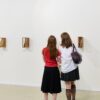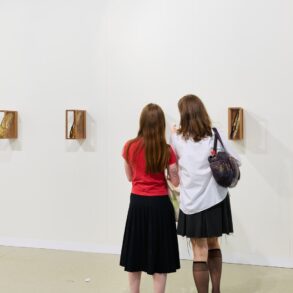Retno Redwindsock (52), an artist from Magelang, produces fermented beverages in her daily life. Her products are divided into alcoholic and non-alcoholic drinks. She has been doing this job since 2010 until now.
“At the beginning, back in 2009 when I exhibited with artist Kana Fuddy Prakoso in Tunisia, I took the opportunity to walk around and get some hibiscus plant seeds to bring home,” said Retno, who completed her Interior Design studies at Yogyakarta ISI from 1992-2001, on Thursday (5/2/2024).
Retno works and resides in Godean, Yogyakarta. In addition to pursuing the field of visual arts, Retno also has a hobby of gardening. Upon arriving home, she planted hibiscus seeds from Tunisia in her home yard.
Placing has the meaning of a creative process that is close to oneself and is carried out in everyday life.
A few moments later, the Tunisian hibiscus plant grew lush. Its flowers were also abundant and larger in size compared to the hibiscus plant variety grown in her own home. “At that time, we had a bountiful harvest of Tunisian hibiscus flowers,” said Retno.
The hibiscus flowers were processed into syrup or served as an infusion like tea leaves. Not long after, around the beginning of 2010, Retno exhibited her work again overseas, in Greece. As usual, Retno really enjoys exploring new places.
In Greece, Retno visited a castle that was used for the production of fermented wine. Retno observed and learned about the wine making process there.
“After returning to the homeland, I want to immediately apply the method of making wine with hibiscus syrup from Tunisia. At that time, I still had a lot of Tunisia hibiscus syrup from the harvest season,” said Retno.
Also read: ”The Queen of Butt” Crawling from Village to Village
Tunisian roselle syrup has a distinctive aroma and taste like wine. Unlike the aroma and taste of local roselle flowers which are more sour or sour. He produces Tunisian roselle flower drinks using a fermentation method that produces alcoholic and non-alcoholic products, such as kombucha or ginger beer.
“The name of the drink product I make is Black Octopus Rosella. There is the word octopus because inside the flower it looks like there are tentacles and the color is blackish red. “It looks like octopus or squid ink,” said Retno.
Installation art
Long before bringing back hibiscus flower seeds from Tunisia, Retno was already fond of making traditional herbal drinks or jamu. Later on, there was a desire to combine the jamu drink with the fermented hibiscus flower product.
”This is what I then displayed as an installation art work in the Local exhibition. “There were 36 bottles containing four variants of roselle and herbal medicine, then I arranged them on the wall with labels from my paintings,” said Retno.
The installation art piece by Retno Redwindsock titled “Indonesia Spice Up the World” was showcased at the Local exhibition in the National Gallery of Indonesia on Tuesday (30/4/2024). The exhibition will run from April 30th to May 16th, 2024.
The four variants of the drink that combines herbal medicine and fermented rosella flowers are Black Octopus Rosella, Miss Red, Fallen Angel, and Strawberry of My Heart. The art installation is titled “Indonesia Spice Up the World” (2024). Retno invites the world to return to using spices like before.
The art installation consists of nine bottles arranged in a row on the wall. There are four rows. Retno provided a brief note for the glass bottle installation artwork as a fermented herbal drink for health. The labels on the bottles also serve as her visual art creation.
Furthermore, Retno explained that Nusantara spices have been known since the Europeans’ voyage in 1512. The benefits of spices have been recognized as food seasonings, beverage ingredients, body warmers, and food preservatives. They contain antimicrobial and antioxidant properties.
Indonesian people have long known spices as a mainstay of medicinal ingredients. Spices are packaged as drinks and are known as herbal medicine.
“The current generation is different. When I produce and market herbal medicines, it is not easily accepted. That’s why I packaged it with a combination of Tunisian hibiscus fermentation,” said Retno.
Also read: Body Expression Chairs
Jamu is a traditional heritage. However, jamu is being crushed by modernity. The current generation does not appreciate jamu. Retno is aware of this and packages it in a different “wrapper”. “Now we are faced with the issue of modern packaging,” said Retno.
Frigidanto Agung, as the curator of the Tempatan exhibition, sees Retno’s installation artworks as pieces that originate from daily life issues she has been pursuing. For Agung, this shows the creative space of female artists that may differ from male artists. Female artists’ works are more detailed and focused on the issues they face, while male artists tend to address broader life issues.
“That is why the exhibition is titled ‘Tempatan’,” said Agung. “Local has a meaning as a creative process that is closely related to oneself and carried out in daily life.”
There is often an observed gap between female and male artists. However, according to Agung, there is actually a position of equality in different ways and spaces.
Irene Agrivina and Gilang W April became accompanying curators. During the opening of the Tempatan exhibition, Irene stated that besides playing a role in the arts, female artists are still burdened with domestic household roles.
“This is different from the role of male artists who are never burdened with domestic roles like women,” said Irine.
Plastic and artificial
The close relationship between female artists and everyday life can be very diverse. In this exhibition, artist Ary Okta showcases an art installation entitled “Artificial Thing”.
Ary made an installation of chicken cages. The cage was hung with pots of plants. Initially, the hung plants were real. Then, in the following days, there was a replacement with fake plants made of plastic.
Through this work “Artificial Thing”, I want to talk about everything around us is turning fake.
Even the chickens that were caged turned out to be fake chickens. For the past eight years, Ary has chosen chicken-shaped statues to represent his artistic expression. These chicken statues are assembled using plastic waste.
The installation art piece titled “Artificial Thing” by Ary Okta is being showcased in an exhibition called “Local” at the National Gallery of Indonesia on Tuesday (30/4/2024). The exhibition will run from April 30th to May 16th, 2024.
At the beginning, Ary had a bitter experience when opening land in the Depok area of West Java to be used as a studio and art teaching space for children. The dug-up soil was filled with plastic waste. The soil composition on the surface was much less than the plastic, which did not easily decompose in the soil.
Ary thought about this and wanted to reduce the amount of plastic waste. Since then, Ary has been collecting plastic waste and turning it into chicken statues. Ary also formed a children’s art class in the same place to learn art.
The students were also encouraged to always bring plastic waste from their respective homes. The plastic waste is then processed into chicken sculptures and various other shapes.
“Through this work ‘Artificial Thing’ I want to talk about everything around us is turning fake,” said Ary.
Bekti Istri’s installation art piece titled “Nahkoda” was featured in an exhibition titled Local at the Indonesian National Gallery on Tuesday (April 30th, 2024). The exhibition will run from April 30th to May 16th, 2024.
Bekti Istri, a painter, displayed a unique bicycle-shaped art installation titled “Nahkoda.” The bicycle was printed using resin casting. The front wheel was made larger than the back wheel, and there is a frying pan between the saddle and handlebars. This symbolizes the dual role of the rider, who not only rides the bicycle to reach a destination but also has to cook while on the bike.
Bekti stated that the struggle requires knowledge, willingness, and spirit to always advance. Without knowledge and spirit, the goal will not be achieved. Paddling requires knowledge to determine direction and move the wheels of life.
In this exhibition, there are still many other works by female artists that are quite profound and touch the emotions. The Local Exhibition by the Empu Gampingan collective presents discourse on visual arts that is rooted in the closest issues to us.
This post was originally published on this site be sure to check out more of their content








